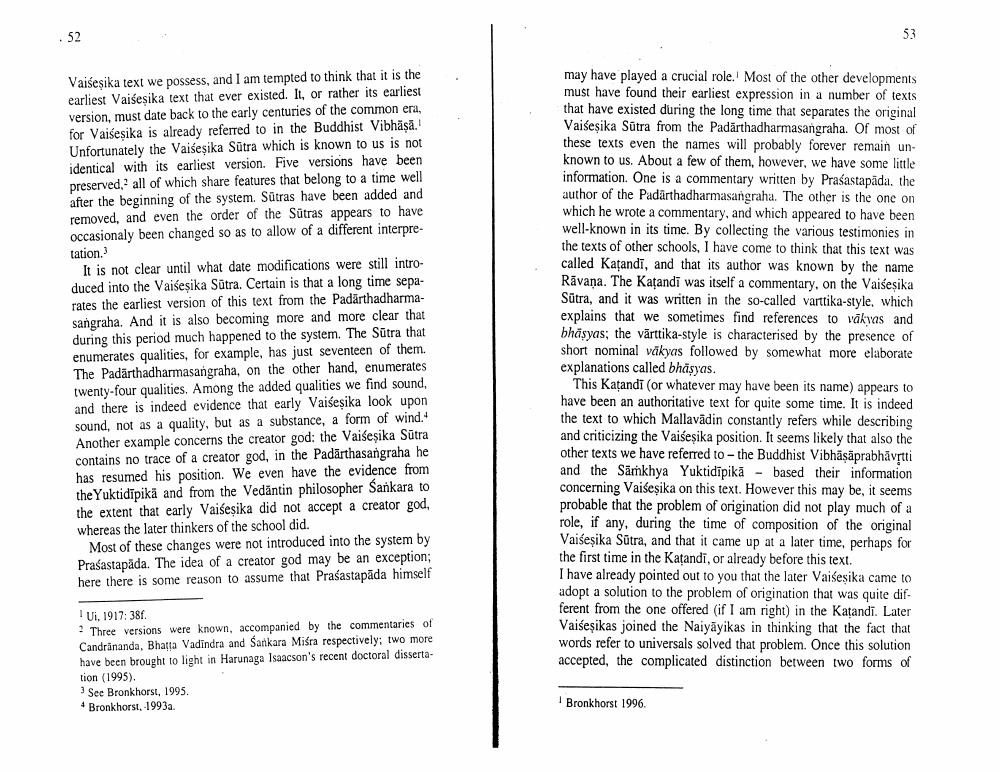________________
. 52
Vaiseşika text we possess, and I am tempted to think that it is the earliest Vaiseṣika text that ever existed. It, or rather its earliest version, must date back to the early centuries of the common era, for Vaiseṣika is already referred to in the Buddhist Vibhāṣā. Unfortunately the Vaiśeşika Sūtra which is known to us is not identical with its earliest version. Five versions have been preserved, all of which share features that belong to a time well after the beginning of the system. Sütras have been added and removed, and even the order of the Sutras appears to have occasionaly been changed so as to allow of a different interpretation.3
It is not clear until what date modifications were still introduced into the Vaiśeşika Sūtra. Certain is that a long time separates the earliest version of this text from the Padärthadharmasangraha. And it is also becoming more and more clear that during this period much happened to the system. The Sūtra that enumerates qualities, for example, has just seventeen of them. The Padarthadharmasangraha, on the other hand, enumerates twenty-four qualities. Among the added qualities we find sound, and there is indeed evidence that early Vaiseṣika look upon sound, not as a quality, but as a substance, a form of wind.+ Another example concerns the creator god: the Vaiśeşika Sūtra contains no trace of a creator god, in the Padarthasangraha he has resumed his position. We even have the evidence from the Yuktidīpikä and from the Vedantin philosopher Sankara to the extent that early Vaiseṣika did not accept a creator god, whereas the later thinkers of the school did.
Most of these changes were not introduced into the system by Prasastapāda. The idea of a creator god may be an exception; here there is some reason to assume that Prasastapāda himself
Ui, 1917: 38f.
? Three versions were known, accompanied by the commentaries of Candrananda, Bhatta Vadindra and Sankara Miśra respectively; two more have been brought to light in Harunaga Isaacson's recent doctoral dissertation (1995).
3 See Bronkhorst, 1995.
4 Bronkhorst, 1993a.
53
may have played a crucial role. Most of the other developments must have found their earliest expression in a number of texts that have existed during the long time that separates the original Vaiseşika Sūtra from the Padarthadharmasangraha. Of most of these texts even the names will probably forever remain unknown to us. About a few of them, however, we have some little information. One is a commentary written by Prasastapāda. the author of the Padarthadharmasangraha. The other is the one on which he wrote a commentary, and which appeared to have been well-known in its time. By collecting the various testimonies in the texts of other schools, I have come to think that this text was called Kaṭandī, and that its author was known by the name Rāvana. The Kaṭandī was itself a commentary, on the Vaiseșika Sūtra, and it was written in the so-called varttika-style, which explains that we sometimes find references to vakyas and bhäṣyas; the värttika-style is characterised by the presence of short nominal vakyas followed by somewhat more elaborate explanations called bhāṣyas.
This Kaṭandi (or whatever may have been its name) appears to have been an authoritative text for quite some time. It is indeed the text to which Mallavädin constantly refers while describing and criticizing the Vaiśeşika position. It seems likely that also the other texts we have referred to the Buddhist Vibhāṣāprabhāvṛtti and the Samkhya Yuktidīpikā based their information concerning Vaiśeşika on this text. However this may be, it seems probable that the problem of origination did not play much of a role, if any, during the time of composition of the original Vaiśeşika Sutra, and that it came up at a later time, perhaps for the first time in the Kaṭandi, or already before this text.
I have already pointed out to you that the later Vaiseṣika came to adopt a solution to the problem of origination that was quite different from the one offered (if I am right) in the Katandi. Later Vaiseșikas joined the Naiyayikas in thinking that the fact that words refer to universals solved that problem. Once this solution accepted, the complicated distinction between two forms of
1 Bronkhorst 1996.




